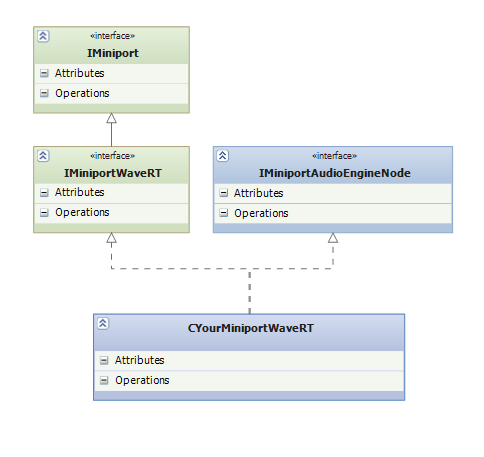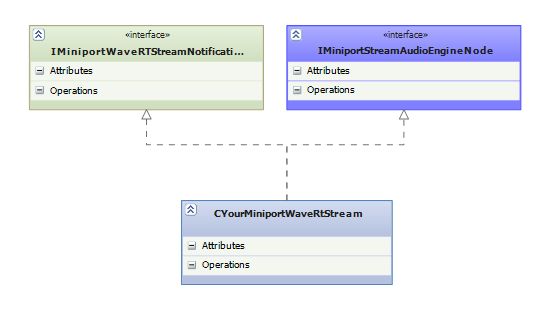Portcls Helper Interfaces for Offloaded Audio Processing
This topic presents the helper interfaces that Microsoft has added to its audio port-class driver (PortCls), to simplify the implementation of drivers that support offloaded-audio processing.
When you develop your WaveRT miniport driver that will work with an audio adapter that is capable of processing hardware-offloaded audio streams, your miniport driver works with PortCls to stream and/or process audio data.
PortCls can handle all the offload-related kernel streaming (KS) properties, and that is what makes it simple to develop a WaveRT miniport driver to expose support for processing hardware-offloaded audio streams. As a result of the updates, PortCls only calls the underlying miniport driver for hardware and/or driver-specific operations via two newly defined interfaces:
You must develop two classes to work with these interfaces, one for each interface.
Working with IMiniportAudioEngineNode
The class that you develop to work with IMiniportAudioEngineNode, must also inherit from IMiniportWaveRT. The methods defined in IMiniportAudioEngineNode allow your driver to use KS properties that access the audio engine via a KS filter handle. The class/interface hierarchy is as follows:

So if, for example, you develop a class called CYourMiniportWaveRT, then as you can see from the preceding diagram, CYourMiniportWaveRT must implement all the methods (shown as Operations) defined for the two parent interfaces.
A skeletal template for such a class would contain the following code:
class CMiniportWaveRT :
public IMiniportWaveRT,
public IMiniportAudioEngineNode,
public CUnknown
{
...
IMP_IMiniportWaveRT;
IMP_IMiniportAudioEngineNode;
...
};
The Portcls.h header file defines these interfaces.
Working with IMiniportStreamAudioEngineNode
The class that you develop to work with the second interface, IMiniportStreamAudioEngineNode, must also inherit from IMiniportWaveRTStreamNotification. The methods defined in IMiniportStreamAudioEngineNode allow your driver to use KS properties that access the audio engine via a pin instance handle. The class/interface hierarchy is as follows:

So if, for example, you develop a class called CYourMiniportWaveRTStream, then as you can see from the preceding diagram, CYourMiniportWaveRTStream must implement all the methods defined for the two parent interfaces.
A skeletal template for such a class would contain the following code:
class CMiniportWaveRTStream :
public IMiniportWaveRTStreamNotification,
public IMiniportStreamAudioEngineNode,
public CUnknown
{
...
IMP_IMiniportWaveRTStream;
IMP_IMiniportWaveRTStreamNotification;
IMP_IMiniportStreamAudioEngineNode;
...
};
The Portcls.h header file defines these interfaces. And for more information about how to develop a driver that can handle hardware-offloaded audio streams, see Hardware Offloaded Audio Driver Implementation.